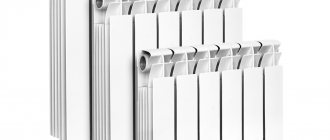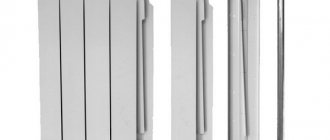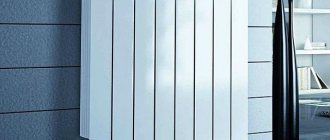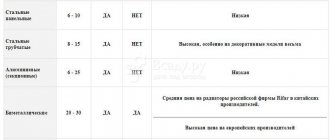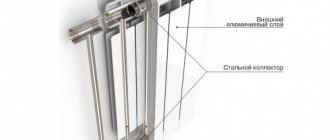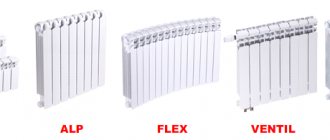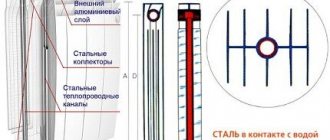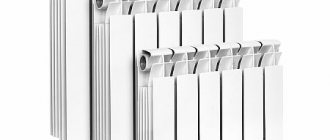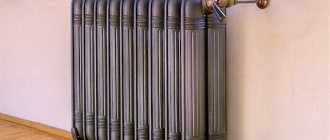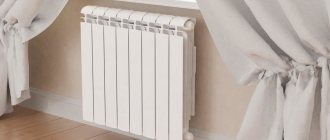Most of Russia's territory is located in latitudes with a cold climate. The heating season there can last six months or more. The population of most regions of our country has to spend a lot of time in heated rooms, so very high demands are placed on heating systems in terms of their efficiency and the presentable appearance of the batteries. Increasingly, more modern appliances are being preferred to the cast-iron monsters of Soviet times. There is a growing demand for bimetallic radiators - heating elements that combine the excellent heat transfer of aluminum and fairly good corrosion resistance of steel.
Battery features, advantages and disadvantages
Bimetallic radiators are a symbiosis of aluminum and steel. Inside the structure there is a steel core, and outside the body is made entirely of aluminum. The use of these two materials made it possible to compensate for the individual disadvantages of analogues made from only one material. For example, due to the steel core, the radiator's resistance to water hammer has improved and sensitivity to low-quality coolant has decreased. The aluminum body is a good heat conductor. It provides quick heating of the room and also reduces the final weight of the radiator.
Thus, the advantages of bimetallic heating radiators:
- the ability of the structure to withstand high pressure and hydraulic shocks;
- resistance to water composition, which is important in central heating systems;
- optimal heat transfer;
- small volume of coolant, thereby increasing the efficiency of the heating system;
- light weight, simplifying independent installation of a bimetallic radiator;
- the ability to add sections if there is not enough power to heat the room.
Minus:
- the price of bimetallic heating radiators is higher than aluminum ones.
Obviously, the advantages outweigh the disadvantages, so it is worth considering installing this type of radiator. But you still need to understand some more points, such as calculations and technical parameters.
What is a bimetallic radiator in cross section?
For monolithic radiators, an alloy of copper and aluminum is used, and in sectional radiators, copper is replaced with steel. In general, steel is characterized by low heat transfer, and aluminum is characterized by sensitivity to corrosion and fragility, thus, the disadvantage of one metal is offset by the advantage of the other, due to which this alloy is more durable and effective.
That is why sectional radiators have some specifics:
- Their service life is no more than 25-27 years;
- The maximum pressure they can withstand does not exceed 35 atmospheres;
- Sectional heat output varies from 100 to 200 watts.
Monolithic radiators are also characterized by a number of features. The service life exceeds 50 years, can withstand pressure of about 100 atmospheres, heat transfer is 100-200 watts.
Thus, monolithic structures are more effective than sectional ones, however, their significant disadvantage is the relatively high price; moreover, the solid structure cannot be changed, i.e. remove or add sections.
Main characteristics
The parameters of bimetallic batteries are indicated in the product passport. It is important to familiarize yourself with them before purchasing so that the radiator is sure to fit the existing heating system and operating conditions.
Let's look at the main characteristics and find out what they indicate:
- Heat dissipation. The parameter is also called thermal power. For bimetallic batteries it is 180-200 W per section. For comparison, cast iron radiators produce 80-160 W, which is noticeably less.
- Maximum pressure. This refers to the maximum value that the structure can withstand without loss of tightness. It is safe to use bimetallic radiators in heating systems where the pressure reaches 30 atm. In this case, the maximum pressure is considered to be up to 200 atmospheres.
- Maximum coolant temperature. Bimetallic radiators can easily withstand 110 degrees, which is enough for most heating systems.
- Center distance. Typically, manufacturers produce standard designs of 500 and 350 mm. Thus, bimetallic devices are suitable for most heating systems in Russia.
- Weight of one section. Let's draw a parallel with cast iron devices. One section of them weighs about 7 kg, while for bimetallic heating radiators it weighs 1-2 kg. The difference is dramatic.
- Life time. Bimetal devices cannot be called the best in this regard, but a period of 25 years of uninterrupted operation is usually enough.
Correctly selected characteristics greatly influence the efficiency of radiators. Of course, if the optimal number of sections is selected and proper installation is performed.
How to calculate the number of sections in a battery
Even a heating system installed in accordance with all the rules will not be able to provide heat to the object on which it is installed if an error was made during preliminary calculations. This primarily relates to calculating the number of sections.
The main characteristic of a radiator is its power, this indicator must be indicated by the manufacturer. Having information about the power of one radiator section, it is easy to calculate how many sections are needed to heat a particular room. To do this, you need to measure the area of the room in which the battery will be installed and perform simple arithmetic. To determine the required number of sections, you need to multiply the area of the object by 100, and divide the resulting value by the capacity of one section declared by the manufacturer. For example, to heat a room with an area of 10 m2, you need a radiator of six sections with a power of 180 W each - the number 5.5555 obtained in the calculation must be rounded according to the rules - up.
Recommendations for selection
It is clear that you need to select the appropriate characteristics of bimetallic radiators. But this is not the only point. Calculations are one of the main tasks when purchasing a radiator. It is recommended to calculate the number of sections using the following formula:
Room area *100/power of 1 section
. For example, we have a 15 m2 room and a bimetallic heating radiator with a heat output of 185 W. We count: 15*100/185=8.1. We round up and get 9 sections.
But that's not all. There are many correction factors that affect the final calculations. This is the average temperature outside in winter, wind rose, floor, ceiling height, etc. Sometimes errors in calculations reach up to 50%, so correction factors need to be taken into account.
A couple more tips for choosing bimetallic heating batteries:
- Choose products from a manufacturer that has proven itself well. And not necessarily imported. Domestic brands are no worse, and the cost of radiators is more affordable.
- For an autonomous heating system there is no point in using bimetal. There are no large pressure surges here, the coolant composition is of a higher quality. Bimetallic devices are better suited for the harsh conditions of central systems, although no one forbids installing them in individual highways.
- Don't go for a very low price. A low price indicates the poor quality of the materials from which the radiator is made. It is unlikely that such a device will satisfy you with its performance and service life.
If possible, it is better to enlist the help of a specialist in choosing batteries. He will help with calculations and determination of characteristics.
Popular manufacturers
Three manufacturers have gained the most popularity on the Russian market: Global, Sira, RIFAR.
Heating devices from Sira group appeared on the Russian market about 20 years ago. Three types of height sizes are available: 30, 50, 80 cm . Each section has two vertical channels, connected to each other using threads, which allows you to add or remove sections at any time. is required for assembly . The cost of one section is from 700 rubles.
Global offers devices with a height of 35 and 50 cm. When connecting sections, special steel nipples and paronite gaskets , which significantly reduces the possibility of leaks. An installation kit is provided with the radiators. There are several design options: Global Style is conservative, Global Style Plus is elegant, Global Style Extra is simple. The cost of one section is from 620−670 rubles (depending on height).
Sira radiators are not suitable for a house in which the heating system was installed more than 30-40 years ago, since the diameter of the vertical sections is only 5-6 mm. For older houses, Global devices with a diameter of 10 mm are more suitable.
The domestic manufacturer RIFAR recently released a new MONOLIT with non-separable channels welded into a single system. This design completely eliminates the possibility of leakage. The main feature is the ability to use coolant with a temperature of 135°C. The cost of one section is from 610−620 rubles.
Bimetallic radiators are ideal for Russian conditions. They easily withstand the abundance of impurities in the coolant and frequent, sudden pressure surges . Aluminum radiators deteriorate much faster. Steel appliances are, of course, more durable, but they are heavy and rust.
You might be interested
Repair of aluminum heating radiators
Power of one section of aluminum radiator
Installation of bimetallic heating radiators
The best aluminum heating radiators for a private home
Dimensions of bimetallic heating radiators
How to properly flush a heating radiator
Heating radiator dimensions: height, width and thickness
Radiators in the floor heating in the house
Calculation of the number of sections of a bimetallic radiator
